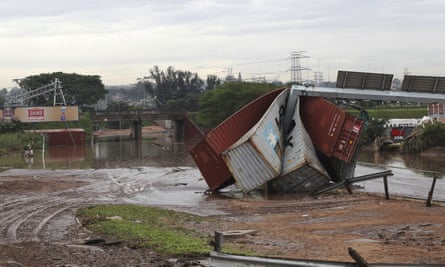South Africa is bracing for more heavy rain in districts hit by massive and lethal downpours earlier this week.
More than 300 people have died in flooding in and around the eastern coastal city of Durban in recent days. On Wednesday the president, Cyril Ramaphosa, described the flooding as a “catastrophe of enormous proportions”, directly linking it to the climate emergency.
“It is telling us that climate change is serious, it is here,” Ramaphosa said as he visited the flooded metropolitan area of eThekwini, which includes Durban. “We no longer can postpone what we need to do, and the measures we need to take to deal with climate change.”
The South African weather service has warned of continuing high wind and rain bringing the risk of more flooding in KwaZulu-Natal and some other provinces over the Easter weekend.

Meteorologists said the flooding had taken them by surprise. Some parts of KwaZulu-Natal recorded almost their average annual rainfall in 48 hours.
“Whilst impact-based warnings were indeed issued in a timely manner it appears that the exceptionally heavy rainfall exceeded even the expectations of the southern African meteorological community at large,” a statement from the weather service said.
The service said although it was impossible to attribute an individual event to the climate crisis, “we can state with confidence that globally (as a direct result of global warming and associated climate change) all forms of severe and extreme weather … are becoming more frequent and more extreme than in the recent past. In other words, heavy rain events such as the current incident can … be expected to recur in the future and with increasing frequency.”
The death toll is expected to increase as search and rescue operations continue in KwaZulu-Natal, officials said.
“KwaZulu-Natal is going to be declared a provincial area of disaster, so that we are able to do things quickly. The bridges have collapsed, the roads have collapsed, people have died and people are injured,” Ramaphosa said.
Along with the loss of life, damage to infrastructure was extensive. Durban’s port, the busiest in southern Africa, was badly hit.
In one township a Methodist church was swept away. A Hindu temple was badly damaged in Umhlatuzana, Chatsworth, near Durban, after a river burst its banks. Elsewhere, flooding triggered massive landslides.
Many people were traumatised. Nokuthula Ntantiso’s house survived, but many others in her Umlazi township did not. “It’s scary, because even last night I didn’t sleep because I was wondering if even this [home] that I’m sleeping in can collapse at any time,” the 31-year-old call centre operator said.
Authorities were seeking to restore electricity to large parts of the province after heavy flooding at various power stations. NGOs were working to distribute clean water. A dozen crocodiles that went missing from breeding ponds after the heavy rains swamped a crocodile farm near Durban were reportedly recaptured.
Rescue efforts by the South African National Defence Force were delayed as the military’s air wing was affected by the floods, Gen Rudzani Maphwanya said. The military was able to deploy personnel and helicopters around the province on Wednesday, he said.
Rain continued in parts of Durban on Wednesday afternoon and a flood warning was issued for the neighbouring province of Eastern Cape.
Durban has struggled to recover from deadly riots last July that killed more than 350 people, South Africa’s worst unrest since the end of apartheid.
